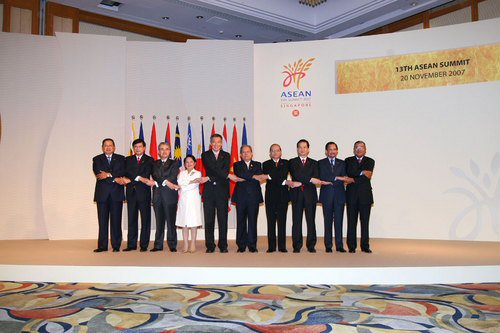Southeast Asia’s Looming Nuclear Power Industry
Geoffrey Gunn
The 2005-07 spike in petroleum prices topping out at $100 a barrel has prodded economic planners across the globe to reconsider their energy options in an age of growing concern over global warming and carbon emissions. The Southeast Asian economies, themselves beneficiaries of an oil and gas export bonanza through the 1970s-1990s, also find themselves in an energy crunch as once ample reserves run down and the search is on for new and cleaner energy supplies. Notably, regional leaders at the 13th ASEAN Summit meeting held in
The 13th ASEAN Summit meeting held in Singapore in November 2007
East and
The high risks and vulnerability of nuclear power plants in geologically unstable zones was dramatically highlighted by the impact of an earthquake upon the Kashiwazaki-Kariwa nuclear power plant in
Fossil Fuel Depletion and the Energy Race
As Laos Vice Prime Minister, Bounhang Vorachith reportedly told
In the Southeast Asian region, country after country appears to be getting that message, although hydro-electric-rich
While impoverished
Since 1984
Alone among the core countries of the ASEAN region,
In 2005
Nevertheless, criticism of the project has emerged from legislators, academics, a broad section of public opinion, and vocal local residents. Not only are unstable geology and environmental concerns stated as reasons for objection, but critics also contend that
In June 2007, some 4,000 demonstrators against the project rallied at the central Javanese site, including a local chapter of Greenpeace. In October, 100 clerics and scholars from the largest Muslim organization in
Rally followed the Ulama fatwa declaring the Muria site haram.
According to a Stockholm International Peace Research Institute SIPRI report,
While
Back in 1994 major criticism of the project came from Australian experts in the field (although not the Australian government) owing to concerns of a potential accident, especially as monsoon winds would expose northern
According to the Tokyo-based Citizen’s Nuclear Information Center (CNIC),
Lessons Learned?
The region has thus far failed to grasp the implications of the negative experience of the
Geoff Gunn wrote this article for Japan Focus. Posted at
Geoff Gunn is Professor of International Relations, Nagasaki University and a specialist on Indonesia, East Timor and the Malay world. He is the author of First Globalization. The Eurasian Exchange, 1500-1800.
Notes
[1] Martin Abugao, “ASEAN summit to promote nuclear energy, solar power” AFP,
[2] Mely Caballero-Anthony and Sofiah Jamil, “The Rush for Nuclear Energy in Southeast Asia,” RSIS Commentaries,
[3] “Asia’s Nuclear Energy Growth,” Nuclear Issues Briefing Paper 2 (February 2007)
[4] Gavan McCormack, “
[5] Ishibashi Katsuhiko, “Why Worry? Japan’s Nuclear Plants at Grave Risk From Quake Damage,” Japan Focus, posted
and see Jeff Kingston and Tom Hyland, “Japan’s Nuclear Disaster and Plans to Export Reactors to Indonesia,” Japan Focus, posted
[6] “Laos’s vice-president: Use of nuclear energy among Iran’s rights,” Teheran Times,
[7] See author’s “
[8] Milton Osborne, “The Water Politics of China and Southeast Asia: Rivers, Dams, Cargo Boats and the Environment,” Japan Focus, posted
[9] “Thai electricity chief sees nuclear power necessary,” Xinhua,
[10] “Vietnam to build first nuclear power plant in central region,” People’s Daily Online,
[11] Contents of Annual Report 2006 Malaysia Nuclear Agency (MOSTI).
[12] Donald Greenlees, “In Indonesia, Japan quake casts shadow over nuclear power plants,” International Herald Tribune,
[13]: “Nuclear power plants destroy the future: Renewable and cheap energy for the people,” Walhi
[14] Tom Hyland, “Nuclear reactor plans on shaky ground,” The Age (Melbourne),
[15] SIPRI 2004, “Indonesia Country Profile: Nuclear Facilities Profiles”
[16] Tom Hyland, “Nuclear reactor plans on shaky ground.”
[17] Tom Hyland, “Nuclear reactor plans on shaky ground.”
[18] Richard Tanter, “The Re-emergence of an Australian Nuclear Weapons Option: Implications for Indonesia and the Asia Pacific,” Japan Focus, posted
[19] Philip White, “Indonesian Anti-Nuclear Activists Visit Japan/Korea,” Citizens’ Nuclear
[20] Karl Wilson, “Philippines: Bataan nuclear plant costs $155,000 a day but no power,” Energy Bulletin,









